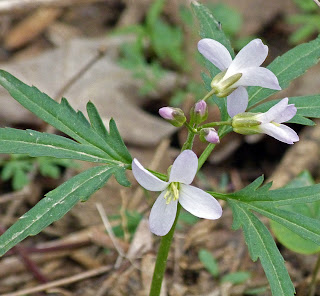 |
| Large Flowered Trillium (grandiflora) |
If asked what my favorite spring wildflower is, I think I would have to say the trillium. According to
Wildflowers of Tennessee the Ohio Valley and the Southern Appalachians, (hereafter called Tavia's field guide, since she is the co-author of it), there are about 30 trillium species found in the eastern U.S. Trillium species are divided into 2 major groups.
Toadshades, also called
sessile trilliums (or should it be trillii for the plural?) have a stalkless flower attached directly above a whorl of 3 mottled leaves.
Wakerobins, also called
pedicellate trilliums, have the flower on a stalk that rises from a whorl of 3 solid green leaves.
 |
| Large Flowered Trillium |
Nothing is more beautiful than a hillside blanketed in these large showy flowers. You can always remember the name since everything on them comes in threes (tri for three); three leaves, three green sepals beneath three petals. They are mostly white, maroon or red, and yellow. The pink ones are usually the white grandiflora which as already been pollinated. We says that they blush after being pollinated.
 |
| Sweet White Trillium (simile) |
Be sure to have the field guide along when you go looking for them, because it can be a trick to distinguish sometimes. Here are some things to look for when trying to tell them apart.
- What color is the center of the flower and the reproductive parts.
- Are the petals smooth or kind of wavy?
- Do the petals curve back over themselves (recurved)?
- Does the flower have a stem that raises it above the leaves? Does the stem bend over so the flowers hangs below the leaves?
 |
| Bent Trillium (flexipes) |
Trillium is one of many plants whose seeds are spread by ants. At maturity, the base and core of the trillium ovary turns soft and spongy. Trillium seeds have a fleshy organ called an elaiosome that attracts ants. The ants extract the seeds from the decaying ovary and take them to their nest, where they eat the elaiosomes and put the seeds in their garbage, where they germinate in a rich growing medium.
 |
| Sessile Trillium (sessile) |
Though trillium flowers are very attractive and inviting, they should never be picked, as the 3 leaves below the flower are the plant's only source of food, and the trillium is likely to die or take many years to recover. It is illegal to pick them in some jurisdictions and in all national parks. After germination, a trillium first produces only one leaf and requires another
6-7 years before it flowers for the first time!
 |
| Red Trillium (erectum) |
Trilliums have some unusual common names. For example, this one (
Trillium erectum) is also known as Stinking Benjamin or Stinking Willie, referring to the pungent odor of the flowers, which have been described as smelling like a wet dog. Other less commonly used names are American True-Love, Bumblebee Root, Indian Shamrock and Threeleaf Nightshade. Although I normally try to avoid Latin names (I can't pronounce most of them!) it is very useful to know the scientific names to keep these trillium straight in your mind since each one has so many different common names.
 |
| Yellow Trillium (luteum) |
The Woodland Garden at Creasey Mahan Nature Preserve hosts a fine collection of trillium on the hillsides. Yellow trilliums have a lemony or sweet citrus aroma if you bend down to sniff it. They range in color from yellow to various shades of green or chartreuse. The sessile trillium commonly found in the woods along Little Huckleberry Creek has an aroma resembling raw beef or carrion, which help to attract flies and beetles which pollinate the plant.
 |
| Painted Trillium (undulatum) |
While in the Smokey Mountain National Park last week I asked everyone where the painted trilliums were, since I'd never seen one before. The field guide notes that they are
infrequent, and you better believe it! The only one sighted were up the 2.2 mile Porter Trail. The rain continued, but slacked off a bit, so off we went. When we finally found them, about 15 flowers grew on a moss covered boulder, but they were only about 3-4 inches tall! Tavia assures me they are normally the size of all the others. These are the only species with bi-colored petals.
Remember that trilliums have 3 of everything? Well, there is an exception to every rule. This 9 leaved trillium can be found at Cherokee Park in Louisville. Have fun finding trilliums!
Naturally yours,
~denapple























